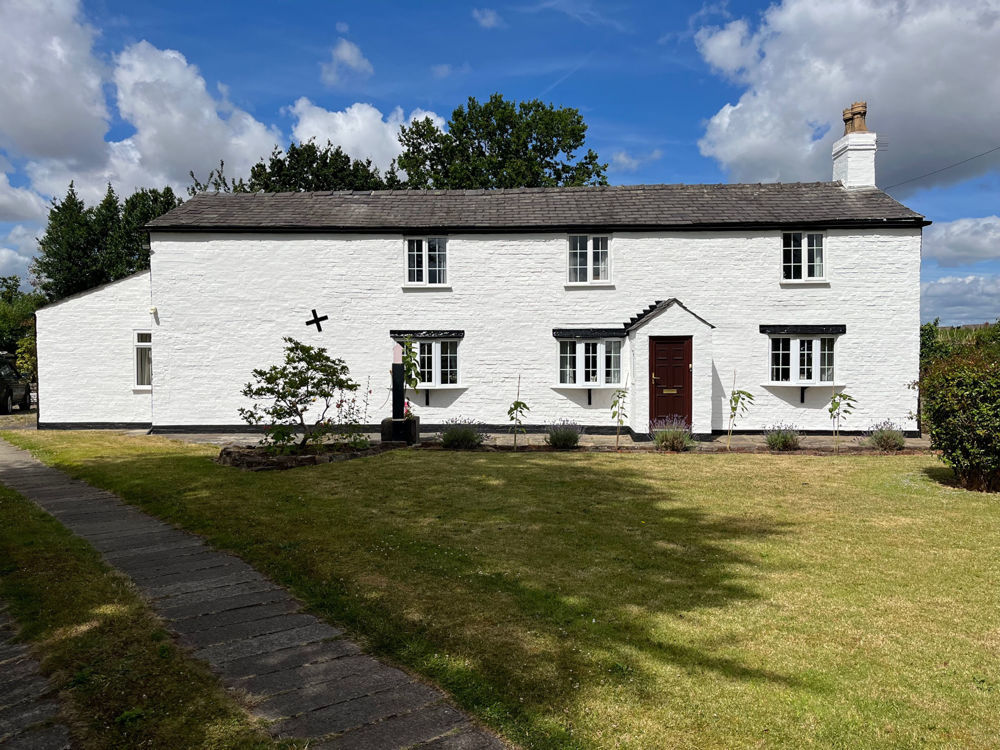
Painting the exterior of a house can seem like a daunting task, however with some useful tips & tricks, it is something that can be done by anyone. We've put together our complete guide to exterior house painting so you can transform your house easily, effectively and stress-free.
What Paint Should I Use To Paint A House?
When it comes to selecting a paint to use, you need to consider the surface you are painting. The exterior of our houses are constructed using either stone, brick, concrete or render, which is why you must use a suitable masonry paint when painting the exterior of a house. Masonry paints are designed not only to adhere to these mineral building materials, but also contain the necessary weather resistance to withstand the weather that our homes endure, especially here in the UK. In order to be durable in all weather conditions, the two most important aspects of a masonry paint are its waterproofing and breathability.
WATERPROOFING
While all masonry paints are developed to withstand some level of weathering, they are not all completely waterproof. Terms like 'weatherproof, 'weather-resistant' and 'water-resistant' are often used to describe a masonry paint's ability to prevent water ingress, however these terms are often used to describe paints that are not fully waterproof and will allow some moisture to enter through the paint. To be fully waterproof, a masonry paint must be water repellent, which causes the rainfall to simply fall off the surface before it can soak into the exterior wall.
BREATHABILITY
Breathability refers to the ability for water vapour to pass through a building material. If a paint with low breathability is used, moisture that would normally freely escape through the material becomes trapped underneath the paint film. This moisture will eventually cause the paint to blister and flake, as it reaches breaking point due to being saturated.
Aside from paint failure, using a low breathability paint can also cause problems to the building materials. Trapped moisture can saturate the masonry surface, leading to crumbling mortar and other structural issues. In some cases, especially on traditional properties, damp problems can be created as moisture has no where to escape, leading to it gathering within the property. The higher the breathability of a paint, the more effective it will be at preventing paint failure and ensuring the surface beneath it stays protected.
To be considered breathable, a paint must have a breathability SD value of below 0.5, which is considered breathable by British Standards.
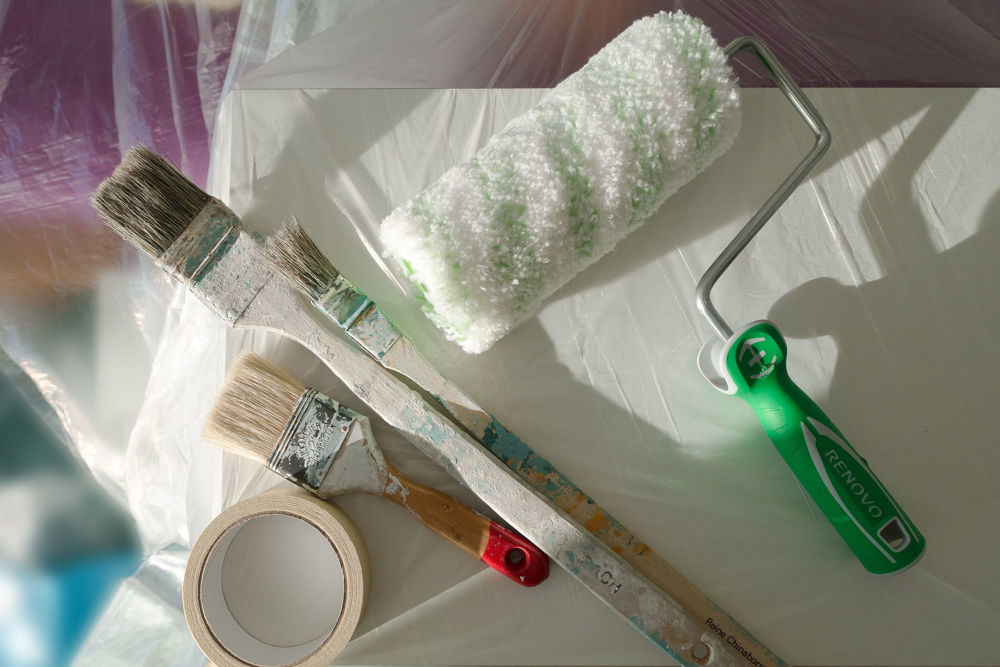
Types of Masonry Paint
There are four main types of masonry paint that you will come across; acrylic masonry paint, silicone masonry paint, oil-based masonry paint & limewash.
ACRYLIC MASONRY PAINT
Acrylic-based masonry paint is what would be considered as a standard masonry paint, as it is a widely available form of masonry paint in the UK. They are water-based formulations that contain acrylic within their formulation. Acrylic masonry paints will often fall under the weatherproof or weather resistant category as they prevent some water absorption, but will uptake some moisture over time. This moisture can then become trapped under the paint film as these paints generally have low breathability which can cause the paint to peel and flake over-time. For this reason, acrylic masonry paints come with lifespans of anywhere from 3-15 years. Having said this, they are often cheaper that other more advanced masonry paints, making them ideal for small, low-budget projects.
SILICONE MASONRY PAINT
Silicone masonry paint, or silicate-based masonry paint, is a new, highly advanced form of masonry paint that contains silicone resins within its formulation. Silicone masonry paint is water repellent, meaning it will cause any rainfall that drops on the surface to simply bead and fall off. This in combination with very high breathability allows it to effectively maintain a dry masonry surface and prevent a build-up of moisture. This provides them with extremely high durability, often coming with a lifespan in excess of 20 years. Another big benefit of silicone masonry paint is that while it can be used on all substrates, it is highly compatible with silicone renders such as K-Rend. If you used a standard masonry paint on this type of render, it would be repelled by the silicone in the render.
Emperor Masonry Paint is a silicone masonry paint that creates a super hydrophobic (ultra water-repellent) surface on any exterior wall that reduces water absorption by 96%. This, coupled with high breathability of a 0.03 SD value means that Emperor Masonry Paint will never peel or flake. In a 25 year weathering test conducted by an independent UKAS accredited laboratory, Emperor Masonry Paint was found to have no change in performance or appearance after a 25 year period. This means it will likely far exceed this lifespan, which is why it comes with a lifetime guarantee.
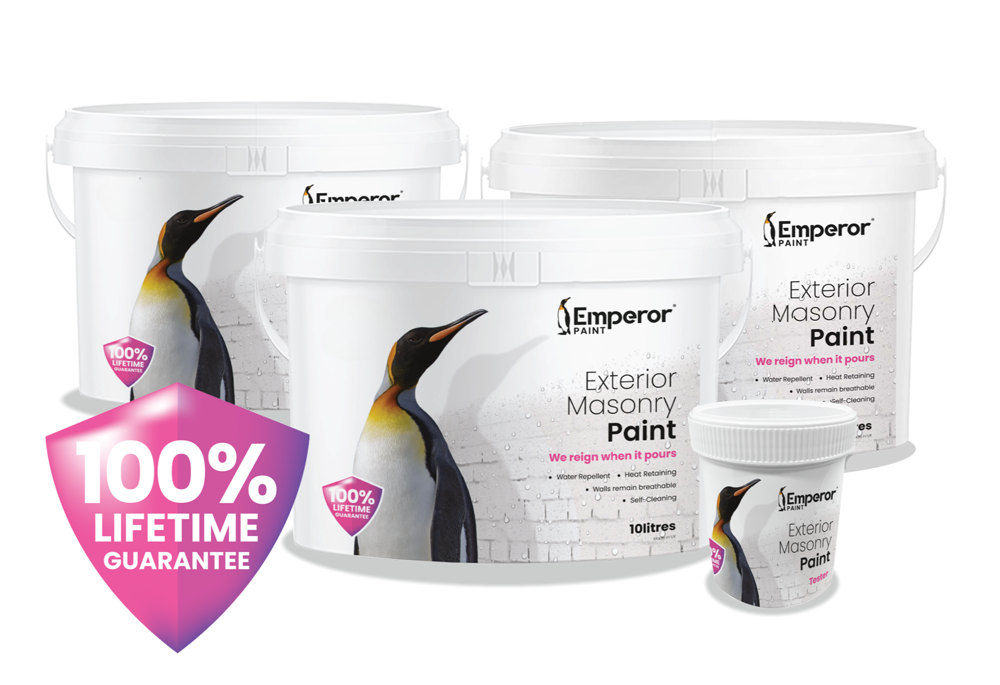
LIMEWASH
Limewash is a traditional form of exterior paint that has been used on properties for hundreds of years. Its high breathability is why it is often considered for use on traditional properties and listed buildings. Having said this, it does not offer the level of durability of modern masonry paints meaning it is often reapplied every few years. For this reason, silicone masonry paint has replaced limewash as the go-to breathable masonry paint for heritage buildings.
OIL-BASED MASONRY PAINT
Oil-based masonry paint, otherwise known as pliolite, can be applied in conditions below 5°C, although it can have very low breathability due to the oil-based formulation. For this reason, it is generally only used in specific industrial and commercial projects.
Things To Consider Before Exterior Painting
Before you get your brushes and rollers out, there are a few things to consider.
PERMISSION
For starters, it is important to clarify whether you can paint the exterior of your house. Generally you do not need any permission to paint the exterior of a house, however if you have a listed building you may need to have permission granted in order to carry out work to the property. This includes ensuring you use an appropriate breathable masonry paint in order to ensure no damage occurs to the property, as well as using an approved colour that is in keeping with the surrounding area.
CHOOSING THE PERFECT PRODUCT
One of the biggest considerations when painting the exterior of a house is the colour. There are a seemingly endless list of colours to choose from, as well as lots of differing colour schemes that can all have a huge impact on the look of a property.
The most popular exterior house painting colour today is white, thanks to its ability to suit any property, whether it be a modern new-build or a traditional, heritage cottage. White also ensures that the property has a beautiful, newly painted look that refreshes the kerb appeal of the building immensely. A common problem that can put many homeowners off using white masonry paint is that it has a tendency to discolour over-time, leaving it looking tired. For this reason, many people opt to use a silicone masonry paint, as the water-repellent technology provide the masonry with self-cleaning properties.
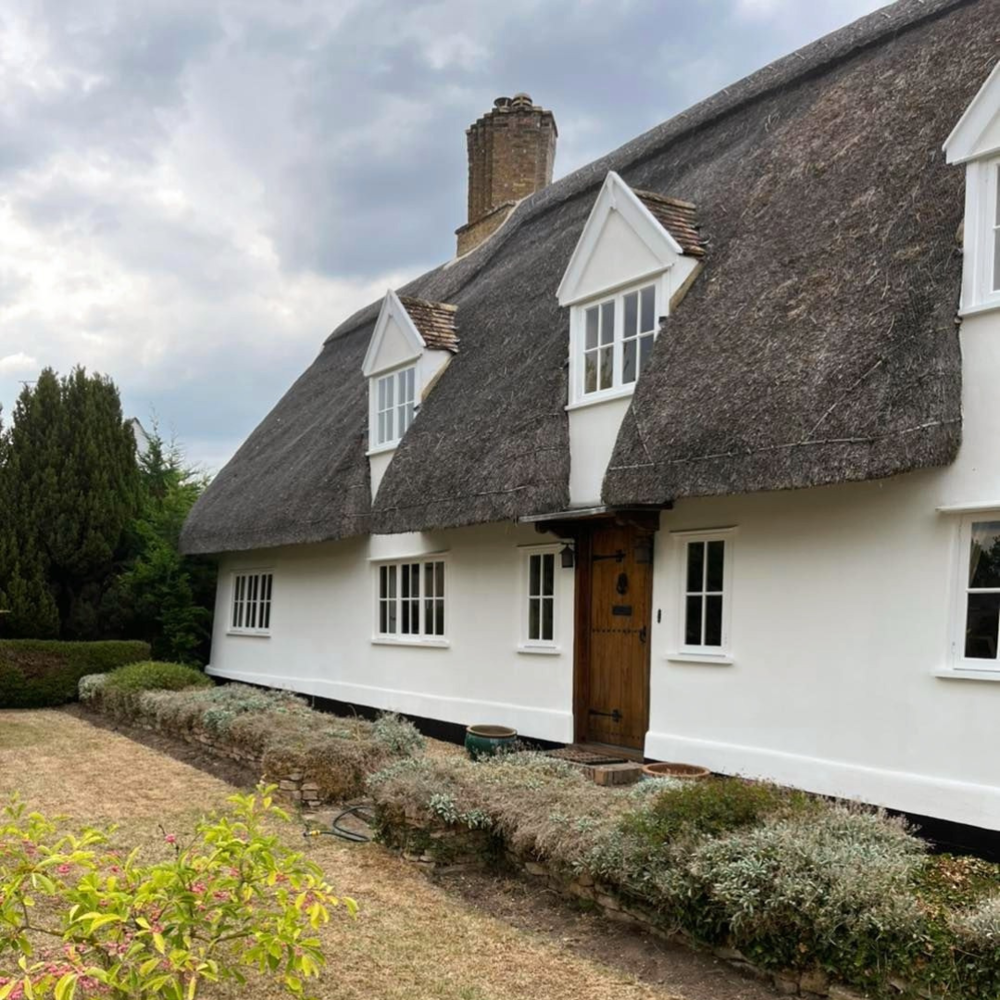
TIP: Cream shades evoke a sense of history, which is why we highly recommend them if you are painting a heritage or listed building.
When it comes to other popular exterior house colours, you will often see cream, light grey & magnolia, which all offer a beautiful, neutral hue to any property. In recent years however, many homeowners have looked away from neutral tones towards pastel shades like pale pink, blue and green, which can all offer a unique and friendly tone.
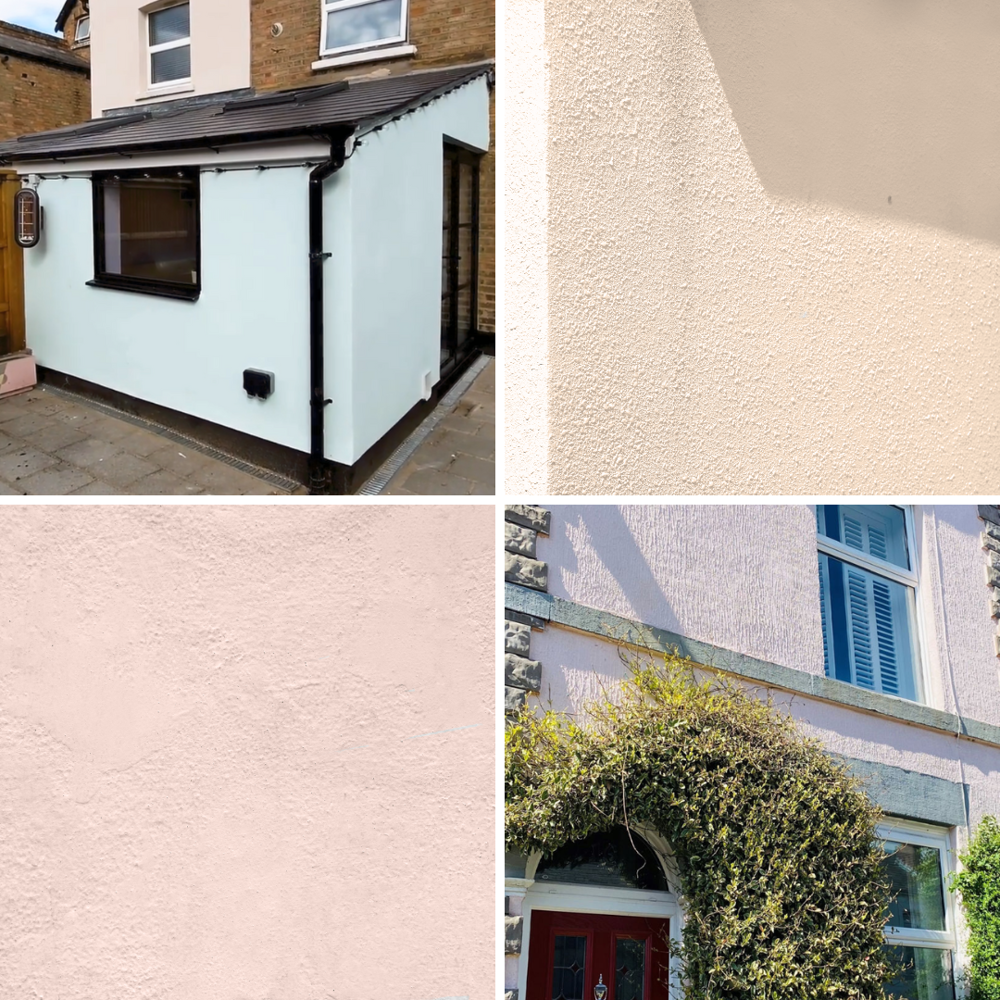
COMPATIBILITY
Lastly, it is important to check if the paint you are using is suitable for use on the surface you are painting. Some renders, such as silicone-based renders like K-rend, can only be painted using a silicone-based paint. Furthermore, renders like lime render require a highly breathable masonry paint to match the highly breathable nature of the lime render. If a low breathable masonry paint was used, the highly porous lime render can become damaged by the moisture.
THE WEATHER
It is crucial to make sure the weather is suitable for exterior house painting before you start. You need to allocate enough time to prepare the surface, apply a primer if required and apply two coats of paint, all before the heavens open. This reduces any risk that rain can wash all of your hard work away. It is also important to not paint in extremely hot conditions in direct sunlight, as this could mean the paint dries too quickly leaving you with a patchy finish. If you are painting in high temperatures, ensure you create some shade to work in.
How To Paint The Exterior Of A House
Now we have covered what paint to use and the most important things to consider, let’s take a look at exactly how to go about painting the exterior of your house. While some steps will vary from project to project, our easy step-by-step guide contains everything you need to know to transform your home.
To paint the exterior of your house, you will need:
- Masonry paint
- Masonry primer (if required)
- Masonry cleaner
- Masonry roller (long-pile roller)
- Paint tray or scuttle
- Paint brush
- Wire brush
- 120 grit sandpaper
- Dust sheets
- Window film
- Masking tape
- Exterior filler & filling knife (may be required)
- Scraper (may be required)
1. PREPARATION
The preparation of the surface you are going to be painting is one of the most important parts of the decorating process. If you do not take time at this stage to ensure the surface is ready to be painted you will experience problems in the future.
Exterior walls are very rarely ready to be painted straight away due to dirt, cracks or peeling paint. If the surface you are painting has any defects such as cracks, begin by repairing these. Start by removing any loose mortar and rubble from the hole or crack, which will ensure that the filler can adhere to the defect properly. Using a good exterior filler such as the Toupret Masonry Repair Filler, fill the masonry by working the filler back and forth into hole or crack. You can then sand this using a 120-grit sandpaper to get a perfectly smooth surface which is ready to paint.
If any previous paint is peeling, scrape this back to a firm edge using a wire brush or a filling knife. You do not need to remove all previous paint, just the parts that are no longer adhered to the wall.
Once the surface is completely sound, the next stage is to ensure it is clean. Dirt can cause paint to not properly adhere to the surface, while any fungal growth on the wall can bloom, causing the paint to fail. Start by cleaning the exterior of the house down with a hose pipe or a stiff brush and hot soapy water. Once the surface level dirt has been removed, you can then apply a fungicidal masonry cleaner such as Emperor Masonry Cleaner using a brush or roller. This will kill any organic fungal growth, meaning once the masonry paint has been applied, there is nothing underneath the paint film to bloom. Allow the cleaner to dry and be absorbed into the surface of the masonry for a minimum of 2 hours. You do not need to remove this cleaner from the wall once applied, as it will continue to do its job after you have applied paint over the top.
We highly recommend that you cover any surfaces that you do not want to paint before you do anything else. This not only ensures you achieve neat results but means the clean up after is a lot easier (trust us!). Apply masking tape along any the edges of the masonry, cover any windows and doors using a window film and put down dust sheets to reduce the risk of paint splashing on to the floor.
2. PRIMING
There is a lot of confusion regarding whether you need to apply a primer before painting the exterior of a house or not. To put simply, if you are painting a bare, unpainted surface you must prime it like most other bare surfaces before painting. A primer not only helps the paint adhere to the wall but also ensures that the porous masonry does not absorb your first coat of paint, which would mean you would have to apply three coats of paint.
You do not need to apply a primer to a wall that has been previously painted. If you are painting a wall that has some areas that are bare and some that are painted, simply spot prime the bare areas with a primer to make sure that the full surface can then be painted.
Not all primers are made the same. Some may be oil-based while some may be water-based. When using Emperor Paint, you must use the Emperor Paint Primer as this contains the same super hydrophobic, highly breathable technology of the Emperor Masonry Paint. Masonry primer is a thin, milky substance that is very easy to apply using a brush, roller or spray machine. It is a one-coat treatment that once dry will ensure the masonry is ready to be painted. If you are applying Emperor Exterior Primer, apply it at 5-8m2 per litre and leave it to dry for approximately 5 hours before painting, depending on the temperature.
3. PAINTING
Now the important part, painting! The best way to apply masonry paint is with a combination of a masonry brush and a long-pile roller. The masonry brush will allow you to 'cut in' around the edges of the wall, while the long-pile roller can cover the large proportion of the wall and ensure all of the nooks and crannies are coated with paint.
We recommend that you thoroughly mix the masonry paint you are using before you apply it. This ensures that all ingredients are evenly dispersed and can also mean that the colour you can achieve is better.
Apply your first coat of Emperor Masonry Paint at a coverage of 5-6m2 per litre on a smooth surface or 3m2 on a heavily textured surface such as pebbledash. Take care to stick to the recommended coverage of whatever paint you are using, as this is crucial in order for the paint to perform to the best of its ability. You can dilute your first coat of paint with 10% of water by volume, which helps to get the first coat applied to the masonry. It is important to still stick to the same coverage whether you dilute the first coat or not. Make sure you start at the top of the wall and work your way down, as this prevents any paint drips.
When you have allowed the first coat to fully dry, which can be up to 8 hours, you can then apply the second coat of paint. Again, allow this to fully dry for up to 8 hours while you remove your masking and clean your tools in hot, soapy water.
TIP: When you stop using your brushes, place them in a sealed bag in order to keep them wet. This will save you time cleaning your brushes after each use!
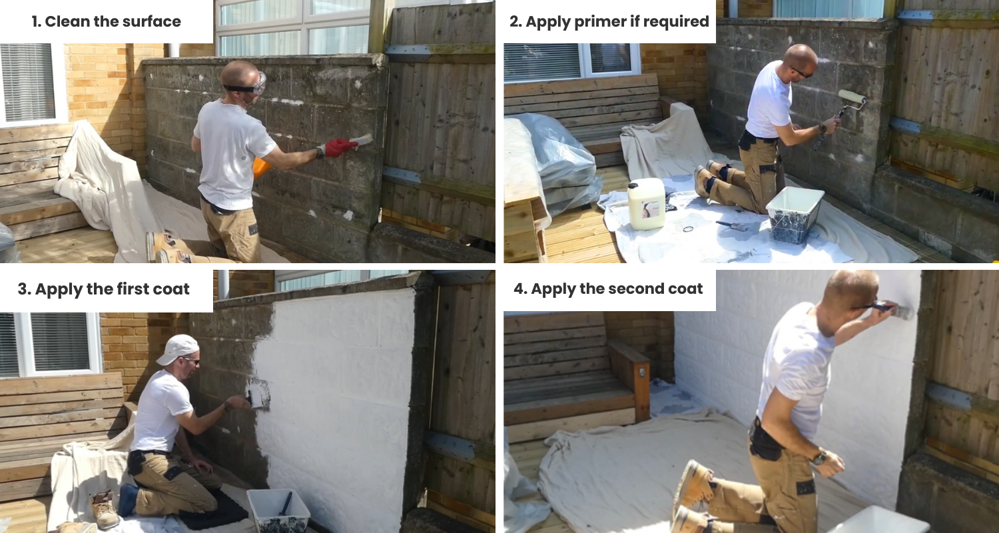
Frequently Asked Questions
Q. HOW MUCH PAINT WILL I NEED TO PAINT THE EXTERIOR OF MY HOUSE?
Estimating the amount of paint you will need can be difficult in any project, never mind when you are painting a full house. There are three things you need to find out in order to get an accurate idea of how much paint you are going to need; the coverage of the paint, the numbers of coats required and the total metres squared of the area you are painting.
Let's start the easy part, the coverage and number of coats required. This will completely depend on the paint you are using. Most good quality masonry paints will cover in two coats, however some will require three coats, especially when covering a dark colour. When it comes to coverage, this will vary from paint to paint but Emperor Masonry Paint for example has a coverage of 5-6m2 per litre. This means that a 10L tub of Emperor Masonry Paint will cover 25-30m2 in two coats of paint.
When estimating the area that you are looking to paint, this will depend on whether you are painting the house exterior or part of it. Simply measure the length and the height of the wall and multiply these numbers together. You can repeat this for each of the walls you are painting and simply add these together to get a total square metreage for the property. Be sure to take 1m2 away from this figure for each window or door, as this will allow you to get an accurate measurement.
Q. I AM SUFFERING FROM DAMP PROBLEMS, CAN PAINTING THE EXTERIOR OF MY HOUSE HELP?
Damp is an extremely common issue in the UK, but is something that many of us do not fully understand. There are three broad types of damp, condensation, rising damp & penetrating damp. While condensation is an internal source of moisture caused by the day-to-day living within our homes, both rising damp and penetrating damp are external sources of moisture. The difference between the two is simple, rising damp is caused by moisture absorbing up through the ground, while penetrating damp is caused by moisture absorbing through the external wall of the property from rainfall.
Identifying which type of damp is causing your house problems is crucial for finding the correct solution. Penetrating damp however is potentially the most common form of damp, which can be identified by peeling paint, damaged exterior walls such as cracks and spalling bricks or wet patches on exterior and interior walls, especially after rainfall.
Penetrating damp can impact properties that have been painted or left natural, as well as properties with a solid wall construction or cavity wall construction. In any case, the moisture is absorbing into the external wall, which is then allowing the moisture to enter into the property. In order to reduce this water ingress, it is important to apply a waterproofing treatment to the external walls to help reduce this water absorption.
There are two options, either a masonry cream such as Emperor Masonry Creme, which is an invisible water repellent treatment for bare, untreated masonry or waterproof masonry paint such as Emperor Masonry Paint, which offers a coloured finish. Crucially, both of these products are highly breathable, as without breathability these waterproofing treatments would trap moisture within the property, causing damp problems to worsen.
Q. I HAVE AN ACRYLIC MASONRY PAINT ON MY HOUSE, CAN I PAINT OVER THIS?
Yes, you can apply Emperor Masonry Paint on to any previously painted walled surface, including walls previously painted with an acrylic masonry paint. Emperor Masonry Paint chemically bonds to previous paints, meaning you do not need to apply a primer.
Q. CAN I CREATE A TEXTURED FINISH?
When painting the exterior of a house, one of the biggest problems can be achieving a consistent even texture, especially if areas have had to be repaired due to cracking. All renders have a level of texture, from light textures to rough textures, meaning filling alone does not always hide the repair. To help with this we developed Emperor Textured Basecoat which can create a wide range of textures using various textured rollers.
As a basecoat, it is applied to previously painted surfaces or bare surfaces, which is then overcoated using Emperor Masonry Paint. Crucially, the basecoat contains our highly breathable technology so does not compromise the performance of the wall, for long-term durability.
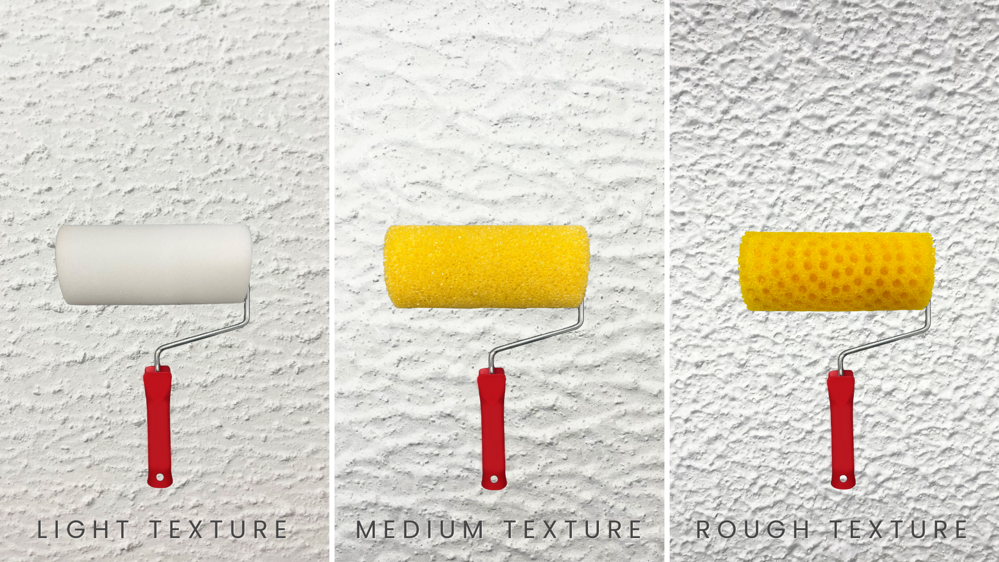
Q. HOW OFTEN WILL I NEED TO RE-APPLY MASONRY PAINT?
The durability of the paint you use will depend on the paint and the conditions it has to endure. Houses by coastal and rural areas will have to endure a lot of weathering, which is why they are often repainted more than other properties. A standard acrylic masonry paint can often need to be repainted in as little as 12 months, whether it be from peeling & flaking or simply discolouring.
For this reason, Emperor Masonry Paint has been developed and independently verified to last a minimum of 25 years in harsh weather conditions without breaking down. The self-cleaning properties also ensure that the house stays looking newly painted, reducing the risk of the discolouration that many houses suffer due to weathering.
We hope we have answered any questions you may have had regarding painting the exterior of your house and how best to go about it. If you have any other questions feel free to get in touch with our team of experts who are on hand to assist you. Contact them today by emailing info@emperorpaint.co.uk or calling 0161 509 9009. Alternatively, shop Emperor Masonry Paint today and get FREE next working day delivery on all orders over £50.

